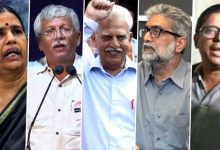The NABARD survey estimates the total number of rural households in India for 2016-17 at 21.17 crore. The definition of “rural” is a broad one, covering revenue villages and semi-urban centres with a population of less than 50,000. Out of the 21.17 crore rural households, 10.07 crore, or under 48 per cent, are “agricultural” — those with at least one member self-employed in farming and reporting annual value of produce at more than Rs 5,000. The remaining 11.10 crore households or 52 per cent are “non-agricultural”. A report for Different Truths.
The All India Rural Financial Inclusion Survey 2016-17, conducted for the first time by the National Bank for Agriculture & Rural Development (NABARD), seems to have some flaws in its findings. One of the reasons could be that the survey was conducted, as pointed out by one of its members, Ashok Gulati, in a drought year resulting in some distortion as it may not have captured the true picture during normal times in rural economy.
This is evident from the fact that one of its major findings is that agriculture generates not even a quarter of rural household incomes. True that farm income might not be adequate but the fact is that it is the major source of income of farmers though the number of persons having it as livelihood is gradually falling due to fragmentation of land holdings and migration.
According to the survey released in August this year, in the so-called agricultural households just over 43 per cent of average income comes from cultivation of crops and rearing of animals. What else one could expect from such a survey in a drought year?
The NABARD survey estimates the total number of rural households in India for 2016-17 at 21.17 crore. The definition of “rural” is a broad one, covering revenue villages and semi-urban centres with a population of less than 50,000. Out of the 21.17 crore rural households, 10.07 crore, or under 48 per cent, are “agricultural” — those with at least one member self-employed in farming and reporting annual value of produce at more than Rs 5,000. The remaining 11.10 crore households or 52 per cent are “non-agricultural”.
If there is less Krishi in Bharat as claimed by it, how is it that India’s food grain and horticulture production is increasing year after year? Last year India achieved a record 275 million tonnes of food grain production and 375 million tonnes of horticulture production, including fruits and vegetables. This year food grain production is expected to better at 285 million tonnes.
According to the survey, whose reference period is 2015-16, the average net monthly income of Indian rural households — after deducting expenses incurred in the course of economic activity — was Rs 8,059. The highest share of this (Rs 3,504) was accounted for by wage labour (both farm and non-farm), which was followed by government or private service jobs (Rs 1,906). On the other hand, agriculture — i.e. income from crop cultivation and livestock rearing — contributed only Rs 1,832.But what’s interesting is that even within “agricultural households”, the share of average income from cultivation and livestock rearing was just over 43 per cent. The balance 57 per cent income in their case, too, was from non-agricultural sources. Though this does not reflect the correct picture as it being a drought year, one thing is clearer: farmers are trying to augment their farm income from other sources. The national rural employment generation programme (MNGREGA) could be contributory factor considering it was a drought year. As it is, agriculture is seasonal in nature and hence there is inherent disguised unemployment or under-employment, as it is called in economic parlance. In such a scenario, it is welcome development, particularly as small farmers do have other sources of livelihood to augment their farm income as returns are low besides high risks due to vagaries of weather.
The NABARD survey not only reconfirms but magnifies the findings of the National Sample Survey Office’s (NSSO) Situation Assessment Survey of Agricultural Households conducted for 2012-13. That survey had estimated agricultural households to constitute 57.8 per cent of all rural households. One reason for the higher share could be that the NSSO’s definition of “rural” did not extend to semi-urban centres with below 50,000 population, which made up 16 per cent of households in the NABARD survey. In the NSSO survey, 67.2 per cent of the average income of agricultural households came from cultivation and livestock rearing. That share is even lower, at 43.1 per cent, in the recent NABARD survey. The methodological differences notwithstanding, both surveys highlight the same fact — of rural India becoming less agricultural, both in terms of the share of families engaged in farming and a diversification of income sources even in their case. There is, however, nothing much to quarrel with this finding as it only states the obvious. With land holding becoming smaller and economic activities progressively increasing in the country, the trickledown effect comes into play and economic development becomes more inclusive, which needs to be appreciated.
The NSSO survey reckoned the average monthly net income of agricultural households in India for 2012-13 at Rs 6,426. That figure in the NABARD survey for 2015-16 is Rs 8,931, an increase of 39 per cent over three years. A doubling of incomes would require this to go up to Rs 17,862 by 2021-22, the target date set by the Narendra Modi-led NDA government. It is significant to note that the doubling is with reference to agricultural household incomes, which could be from both farm and non-farm sources. This, however, is going to be a tough ask considering the hiccups in the domestic as well as global economy.
The vigorous implementation of the government’s flagship programme, the Jan Dhan Rural Yojana, to ensure that every household gets a bank account has ensured rural households now have access to banking and have savings. But investment levels and pension and insurance coverage remain still very low. Low insurance cover is one of the reasons for the farm distress as it led to high indebtedness, particularly in times of crop failure, which is quite frequent in India due to drought and floods.
The survey also showed for obvious reasons that levels of indebtedness were high. The majority of the agricultural households were indebted, with the amount of loans nearly equalling annual incomes. More than one in two agricultural households surveyed were indebted. The average outstanding debt for these households was Rs 1.04 lakh but most borrowed from financial institutions rather than money lenders. One in two rural households saved in 2016-17. Nearly one in two rural households that saved did so in financial institutions, with more agricultural households saving in such institutions compared to the non-agricultural households.
The survey covered 245 districts across 29 states and was done across Tier III to Tier VI cities. It covered 40,327 households and 187,000 people and covered all aspects of financial inclusion, including loans, savings, investments, pension, insurance and remittance. There are, however, questions about whether the sample is really true representative of the entire farm households in the country, which is pretty large and varied.
NABARD chairman Harsh Kumar Bhanwala said the survey shows there is scope for banks to provide loans to more people rather than lend to the same set of people. Insurance coverage remains poor. Only around one in four households has access to insurance coverage. Old age income security in the form of pensions is worse. Only one in five households has access to any type of pension. This is one area where the government will have to work hard as still a lot needs to be covered to fully achieve financial inclusion, particularly in rural India.
K R Sudhaman
©IPA Service
Photo from the Internet





 By
By

